nForce 500: nForce4 on Steroids?
by Gary Key & Wesley Fink on May 24, 2006 8:00 AM EST- Posted in
- CPUs
Synthetic Graphics Performance
The 3DMark series of benchmarks developed and provided by Futuremark are among the most widely used tools for benchmark reporting and comparisons. Although the benchmarks are very useful for providing apples-to-apples comparisons across a broad array of GPU and CPU configurations, they are not a substitute for actual application and gaming benchmarks. In this sense we consider the 3DMark benchmarks to be purely synthetic in nature but still valuable for providing consistent measurements of performance.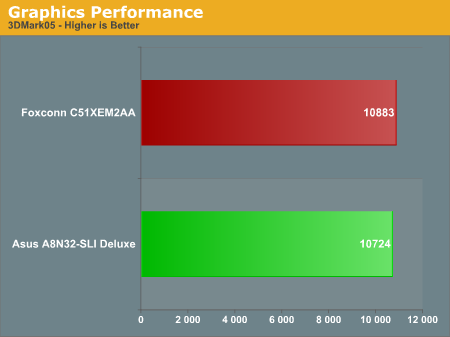
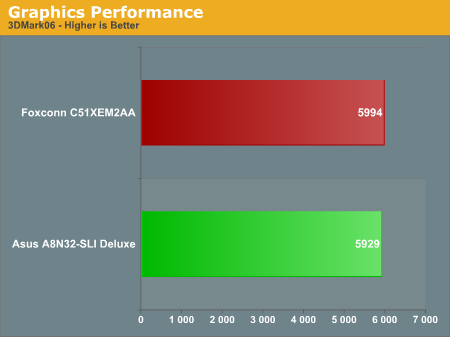
Our nForce 590 SLI system improves upon the performance of the nForce4 system by an average of 1%. These test results are basically a tie and indicates both platforms are performing equally with the same video card.
General System Performance
The PCMark05 benchmark developed and provided by Futuremark was designed for determining overall system performance for the typical home computing user. This tool provides both system and component level benchmarking results utilizing subsets of real world applications or programs. This benchmark is useful for providing comparative results across a broad array of Graphics subsystems, CPU, Hard Disk, and Memory configurations along with multithreading results. In this sense we consider the PCMark benchmark to be both synthetic and real world in nature while providing consistency in our benchmark results.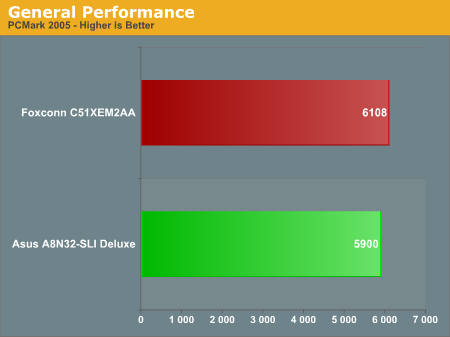
The margins are little wider at 4% in the PCMark05 results, but the margin of error in PCMark05 is also slightly larger. It is obvious from our test results so far that either platform provides excellent results. If you have a socket 939 platform and are happy with its feature set then we do not see a reason to upgrade at this time.
Rendering Performance
We have added the Cinebench 9.5 and POV-RAY 3.6 benchmarks as they heavily stress the CPU subsystem while performing graphics modeling and rendering. We utilize the standard benchmark demos in each program along with the default settings. Cinebench 9.5 features two different benchmarks with one test utilizing a single core and the second test showcasing the power of multiple cores in rendering the benchmark image.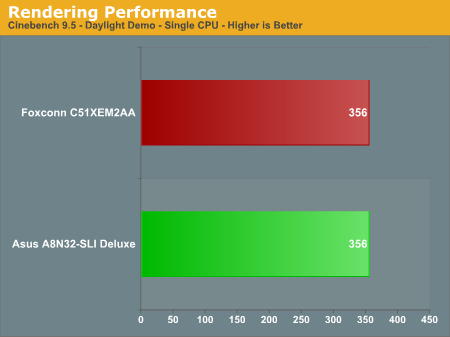
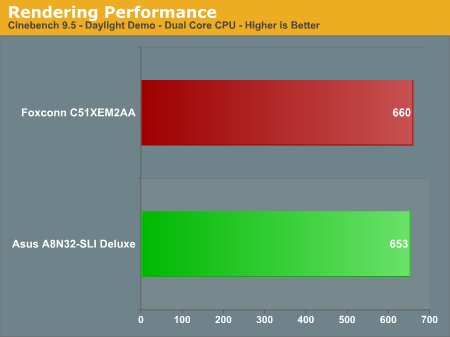
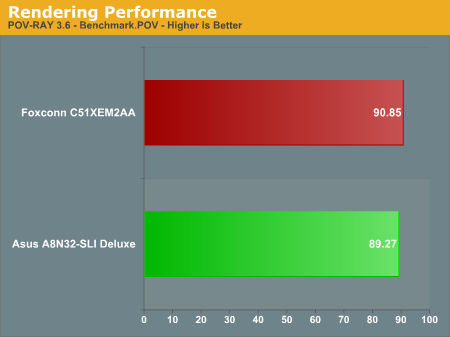
The nForce 500 desktop platform shows small and almost imperceptible differences in these benchmarks, with the 590 AM2 performing slightly better in the demanding POV-RAY benchmark. Once again both platforms are performing equally.










64 Comments
View All Comments
ayqazi - Wednesday, July 5, 2006 - link
I'm a little tired of hearing about so-called "chipset" hardware RAID. The writer of this article constantly made it seem that it was the chipset that was responsible for performing RAID operations on the disks, whereas nothing could be farther from the truth.Yes, the chipset may offload some of the work, but (in the case of RAID 5) the major calculations, like the XOR calculations, are done by the host processor.
According to [L]http://linuxmafia.com/faq/Hardware/sata.html#faker...[/L] and [L]http://spamaps.org/raidtests.php[/L], Linux-based software raid is much faster than so-called fakeraid, since it has been optimised and developed more than the software drivers of the fakeraid chipsets.
Anyway, just pointing out something that gets on my nerves a bit.
raildogg - Saturday, May 27, 2006 - link
I think for most of us who have a nForce 4 ultras and SLIs, it doesn't make sense to upgrade to AM2 motherboards and processors. We'll need new memory too. No performance increase. Just upgrade to a X2 and that should be a good upgrade for those of us who don't have it yet.Powered by AMD - Friday, May 26, 2006 - link
When in the article says:"In fact, the less than stellar write performance of the nForce4 in RAID 5 continues in the "new" chipset"
It does mean that the write performance is good or not?
thanks!
Zoomer - Saturday, May 27, 2006 - link
Means just as bad as before, in a nicer manner. :)Gary Key - Saturday, May 27, 2006 - link
Thank you for the perfect reply. ;-) NVIDIA is working on this for the next refresh, their reasoning at this time is they did not want to introduce potential data corruption issues by improving the performance with the current chipset and driver base. It continues to reinforce our belief that although the nF590 SLI is the most feature laden chipset out at this time, the core continues to be nForce4 Plus in our eyes. This is not bad at all, just what can you do with a less than stellar CPU release (still an extremely strong CPU lineup) from a marketing viewpoint. I think NVIDIA and ATI are going to be hamstrung on sales with the AM2 release but hopefully they can make it up when Conroe (Core 2 Duo) launches shortly. :) The bios revisions we have received this week have improved performance but nothing that would make a nf4SLI/4800+ owner want to upgrade yet.
SonicIce - Wednesday, May 24, 2006 - link
AM2 can just die.afrost - Thursday, May 25, 2006 - link
i'm glad you took the time to type all that out.....KHysiek - Thursday, May 25, 2006 - link
Well, but it does say precisely right about the whole AM2 transition.This is the most pointless hardware upgrade I've seen forfew last years.
The only significant advantage of AM2 is a bit more featured mainboard. And you pay more for less speed. I think AMD is on the way down and no K8L can save them, cause it will be quad core only. What typical user needs quad core for price AMD keeps (like their pricing for current X2 CPU's versus Intel's).
Core 2 is huge leap forward and combined with Intel manufacturing power will make big push back for AMD in coming months.
Pirks - Wednesday, May 24, 2006 - link
Gary, what's about that QoS network driver/protocol hanging around in my WinXP for years? I heard it does some quality of service stuff/packet prioritizing/etc soo... is FirstPacket just an interface for this Microsoft QoS thing? Or is nVidia didn't know about it and reinvented the wheel?Gary Key - Wednesday, May 24, 2006 - link
I raised this question at the Editor's conference as it appeared to me they decided to take advantage of some hooks/protocols in XP. I have a meeting with the platform manager tomorrow and hopefully some discussions with the Network guru next week after his return from vacation. I am trying to get an answer before our roundup is published. I noticed some interesting inter-actions during our network testing, will say this, they (NVIDIA) really took the networking side seriously on this release although most of the features are designed for the server/workstation market, but we get them for free on the desktop. We expect further hardware/driver improvements in the next refresh. I am trying to compare the outbound FirstPacket numbers to a D-Link Gamer Lounge at this time along with how both prioritize packets on the outbound lanes. There are so many different tests and options in just the new networking features to run that is a bit overwhelming at this point and of course the new draft-N equipment showed up this week also. ;-)